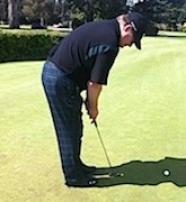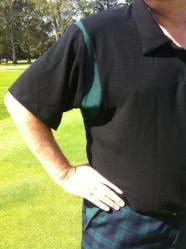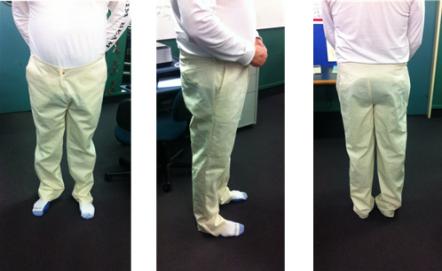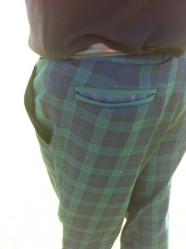Golfing outfit leads to outstanding scholarship

Beginnings
Looking the part and being comfortable on the golf course was important to Kate Hirschman’s father, Dennis – an avid golfer. Dennis also had ideas about developing a line of comfortable golf clothing.
His requirements provided the perfect challenge for a successful scholarship project for Kate. She scored 22 out of a possible 24 in the scholarship standard and was awarded an outstanding scholarship.
Project management
Kate recognised straight away that she would need a rigorous approach to planning to ensure that she completed the project on time.
She had found year planners useful in previous technology projects. A class visit to a company that used year planners further convinced her that they are an effective tool valued by technologists in industry.
She divided the project into key milestone stages, reflecting on her practice at the end of each and adjusting her plans if necessary to ensure completion in the timeframe.
Three applications on Kate’s iPhone proved invaluable:
-
Notes
(to record discussions with stakeholders, other people she was consulting with, and her teacher) -
Calendar
(to record dates and time tasks, key stages, resources, meetings, and so on that needed arranging) -
Reminder
(to prompt her about specific tasks needing action).
Acceptable dress code

Most golf clubs have dress codes. Kate didn’t know much about what makes golfing clothing acceptable, both in terms of the club and the wearer, so she spent time researching this aspect.
She interviewed her father, surveyed other golf players at the club, and investigated the range of golfing clothing available in the current market. Her research focused on social, functional, and aesthetic considerations.
To ensure that the survey would suit the audience and she would get a useful response, Kate involved Dennis in developing the questions. In addition to the survey, she interviewed individual members to clarify their responses where necessary.
Materials
Kate and her father wanted the golfing outfit to stand out but it also had to be functional.

The choice of fabric type, pattern, and colour needed to reflect the views of the wider stakeholders because they were considering the possibility of mass producing the garments. Kate’s research showed that the members of the golf club preferred a black or white polo shirt and a subdued pattern for the trousers rather than anything too bold and bright.
Kate chose a tartan material for the pants – noting that the game of golf started in Scotland and the original players wore kilts. The fabric was a polyester viscose blend and met all of the material specifications for this garment, including durability, soft texture, easy laundering.
She chose a black merino polo knit for the t-shirt because:
- it met the golfers requirements in terms of colour
- the wicking properties of merino wool meant it could draw moisture away from the body
- it has antimicrobial properties
- merino is a natural fabric with an end life that would have minimal impact on the environment.
Modelling
Using the feedback from Dennis and the other golfers surveyed, Kate developed four conceptual designs, shared these again, and finalised her brief.
Functional modelling was carried out and a toile tested for fit for both the top and pants. The calico material did not have the stretch of the material chosen for the prototype but the toiles were comfortable and, with some adjustments, fitted.

Kate was also able to reduce fabric wastage by using the final pattern pieces and planning out the exact amount of material needed for the prototype garments.
Issues such as pocket placement in the pants and pocket fabric, shoulder fit, and mastering the placket construction in the polo shirt, were resolved during the development of the prototype.

Scholarship report writing
Kate’s teacher Carol Rimmer ensured that Kate was collecting evidence for her report throughout her practice.
When Kate started the report, she looked at formats used by previous scholarship students and a report writing format by Lesley Pierce (former National Coordinator Technology Education and Team Solutions).
Kate developed her headings and wrote the report on the basis of the problems she resolved when developing the prototype.
Evaluation and reflection
Fitness for purpose

Dennis found the final outcome comfortable to play golf in, and his problem of pocket ride-up solved (Kate used a slippery waterproof material to prevent this and to give Dennis a place to store wet items). The pocket was the right size for the divot tool and other items he kept in his pockets. He liked the patterned material in the pants, the black merino top, and the style and fit of both of these garments.
The textiles students at Havelock North High participate in a fashion parade at the end of the year. Dennis was happy to model the garments and received good feedback from other golfers:
At the fashion parade two of the golfers from the club came up and asked us if we would consider going ahead and manufacturing them.
Dennis Hirschman
Kate also noted that when her father purchased more clothes for golf, he used the new understandings he had gained about the fitness for purpose of garments.
Fitness for purpose in its broadest sense
The concept of fitness for purpose in its broadest sense was clearly addressed throughout the project.
Fitness for purpose in its broadest sense is a concept described at level 8 of the curriculum and also within the scholarship standard. (See the NZQA website at Scholarship Performance Standard, Technology.) One of the subject specific definitions for the standard states:
Technological experiences will include:
- undertaking technological practice to develop a technological outcome(s) that is justified as fit for purpose in the broadest sense and shows elements of elegance and/or originality.
Fitness for purpose in its broadest sense relates to the outcome itself as well as to the practices used to develop the outcome. Kate addressed this notion in the following ways.
Sustainability of resources used
She used merino fabric from Levana Textiles in Levin for the polo shirt and planned cutting to minimise waste.
Practices used in manufacture
She showed awareness of intellectual property, noting that where fashion design has been copyrighted, care must be taken to be original.
Maintenance
Some overseas golfing garments purchased by Kate’s father unravelled following one wash. The garments Kate developed were constructed to a high standard using acceptable codes of practice to prevent the requirement for excessive maintenance.
Determination of lifecycle
The garments were such that upcycling could have been considered as a possibility and it was noted that the natural fibres that made up the majority of the materials would break down fully.
Cultural appropriateness of trialling procedures
Kate worked sensitively with her father developing and trialling the mock ups. He was often fitted in the classroom. Privacy was always considered and Kate ensured that he was comfortable during these fitting sessions.
Mimicking the practice of existing technologists
Kate’s project included investigating the practice of the garment manufacturer SOMA and the materials handling equipment company Haden and Custance. Both of these companies influenced her practice and either confirmed her approach or provided additional relevant ideas. SOMA provided information on what she needed to consider for the mass production of garments, and Haden and Custance confirmed her approaches to project management.
Planning
Using her disciplined approach to project management, Kate finished the garments on time and produced her scholarship report in the two weeks prior to finishing school for NCEA examinations.
Kate’s thinking about planning helped her with this:
When I developed my year plan, I sat down and thought about the specific things I would have to do at each stage and the resources needed. For example, you can make lots of concepts but if you research and narrow down your ideas before this, then you can limit the number of concepts. I worked out what was useful to mock up and what I could leave for prototyping. I was, all of the time, looking at where I could make time by saving time.
Kate Hirschman
What next?
Kate has started her teacher training at Victoria University this year, and has found her experiences in planning useful:
The process that you follow in technology can be applied to lots of other things. How to plan and how to manage everything definitely helps with managing my time this year.
Kate Hirschman
Kate and her father have not forgotten that they planned to mass produce a golfing range – they are determined to pursue this idea in the future.
Kate scholarship report 2013 (PDF, 4 MB)
Kate school supporting evidence (PDF, 11 MB)


